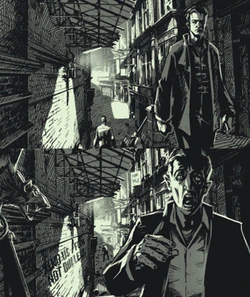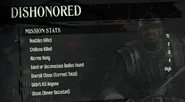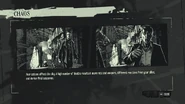
An illustration of Dunwall in high chaos.
Chaos is the element that affects the actions and reactions of characters during Dishonored and determines the fate of Emily Kaldwin and Dunwall.
In Dishonored, Chaos controls how Corvo's quest unfolds and its eventual resolution. It affects the number of guards present in each area and the strength of their forces, and increases the quantity of rats and weepers encountered during missions. It is chiefly calculated by the number of people Corvo kills, but is also influenced by several side objectives.
It has been reported that, for High Chaos to be achieved, Corvo must kill 20% of the human population per mission. If his total kills exceed 50% of the population seen in Dishonored, Dunwall is irrevocably thrown into chaos, and the High Chaos ending is depicted. Variations on the totals seem to trigger minor differences between chaos levels, such as Samuel's behavior in The Light at the End.
High Chaos
The most violent path Corvo can choose, high chaos is achieved by killing many human characters.
Having a high chaos rating when Corvo arrives at his final mission drastically changes the situation he encounters on Kingsparrow Island. Cosmetic changes, such as the presence of a large storm on the island, are paired with changes to the environment and story line that will alter how Corvo must navigate the area. At this level, Samuel will fire a flare to alert the guards to Corvo's presence, as a demonstration of his disgust with Corvo's actions.
Medium Chaos
Medium Chaos is a high chaos state wherein Corvo has not caused enough chaos to warrant the highest rating. Samuel will not alert the guards on Kingsparrow Island to Corvo's presence, but will castigate him and say he never wants to see Corvo again. The events during the ending sequence will also be less severe than in high chaos.
Low Chaos
Low chaos requires Corvo to avoid killing both enemies and civilians. Non-human enemies such as rats, river krusts and wolfhounds do not affect chaos. Early on, when there are many guards in Corvo's path, following a low chaos approach can be difficult--however, in some of the later, less populated areas, it is significantly easier.
Chaos System
Effects of Chaos
| High Chaos | Low Chaos |
|---|---|
| Increase in the number of guards present. | Decrease in the number of guards present. |
| Increase in rat and weeper populations. | Decrease in rat and weeper populations. |
| More hostile reactions from Loyalist members. |
Loyalists will be friendlier and more respectful toward Corvo. |
|
Increase in story-related deaths. |
Decrease in story-related deaths. |
| Negative changes in Emily's behavior. | Positive behavior from Emily. |
Increasing Chaos
| Action | Mission |
|---|---|
| Kill assassination targets. | General |
| Kill members of the City Watch. | General |
| Kill civilians. | General |
| Poison Slackjaw's still for Granny Rags. | High Overseer Campbell |
| Kill Lord Shaw. | Lady Boyle's Last Party |
| Kill the Royal Interrogator. | Return to the Tower |
| Use the Arc Pylon to kill hostiles. | The Loyalists |
Decreasing Chaos
| Action | Mission |
|---|---|
| Deal with assassination targets in a non-lethal manner. | General |
| Avoid the use of lethal force against guards. |
General |
| Avoid the use of lethal force against civilians. | General |
| Save Geoff Curnow from Thaddeus Campbell's assassination attempt. | High Overseer Campbell |
| Save Berthold and his sister from zealous Overseers. | High Overseer Campbell |
| Rescue a woman from a swarm of rats in an abandoned factory on the north side of Kaldwin's Bridge. | The Royal Physician |
| Release Anton Sokolov's test subject from confinement. | The Royal Physician |
| Save the plague survivors in Creating a Safe Haven. | The Flooded District |
| Use the Arc Pylon to incapacitate hostiles. | The Loyalists |
Ending
Dishonored is concluded in a manner that reflects Corvo's actions. If a low chaos path is attempted, more than 80% of the total human population, including weepers, must survive Corvo's adventure.



